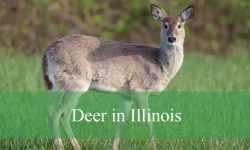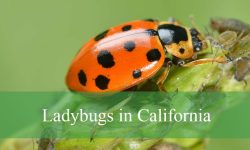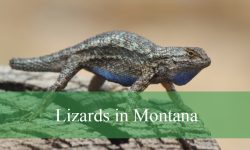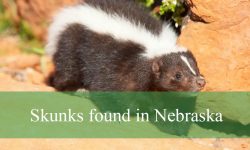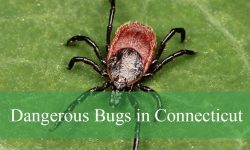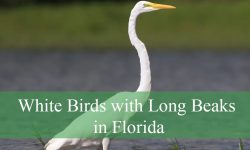Backyard birds in Kentucky add color and life to gardens, parks, and neighborhoods throughout the state. Learning to identify these birds makes spending time outdoors more enjoyable. From the bright Northern Cardinal to the lively Carolina Chickadee, Kentucky’s backyards host many interesting bird species.
This guide features 30 common backyard birds in Kentucky, with pictures and identification tips. It includes details about their size, colors, behaviors, and how to spot them in your own yard. Knowing these birds helps create a welcoming space that attracts a variety of feathered visitors.
Understanding backyard birds in Kentucky allows you to appreciate the natural beauty around you. Watching their behaviors, feeding them, or simply listening to their songs brings charm and excitement to everyday life. Let’s discover the wonderful world of Kentucky’s backyard birds together!
Common Backyard Birds Found in Kentucky
Northern Cardinal
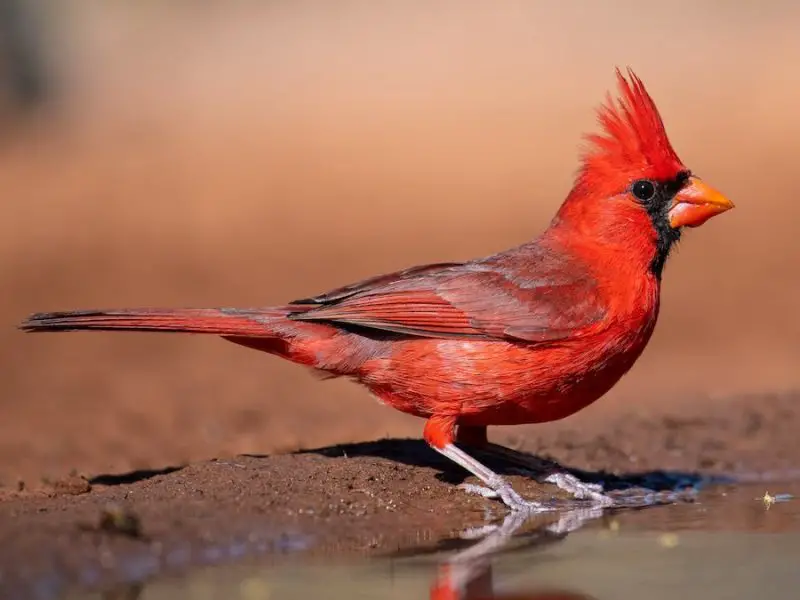
The Northern Cardinal is one of the most iconic birds in Kentucky and holds the honor of being the state bird. Males are easily recognized by their vivid crimson plumage, black mask around the face, and a prominent crest on the head. Females are more subdued in color, with warm brown feathers tinged with reddish hues on the wings, tail, and crest.
This species is medium-sized, measuring about 8–9 inches in length with a wingspan of around 10–12 inches. Cardinals are year-round residents and frequently visit backyard feeders, especially those offering sunflower seeds and safflower. Their strong, conical beak makes cracking seeds easy.
Northern Cardinals prefer wooded edges, suburban areas, and dense thickets. In Kentucky, they thrive in residential yards, parks, and forested areas. Their clear, whistled songs can be heard throughout the year, and males often sing to mark territory and attract mates.
Carolina Chickadee
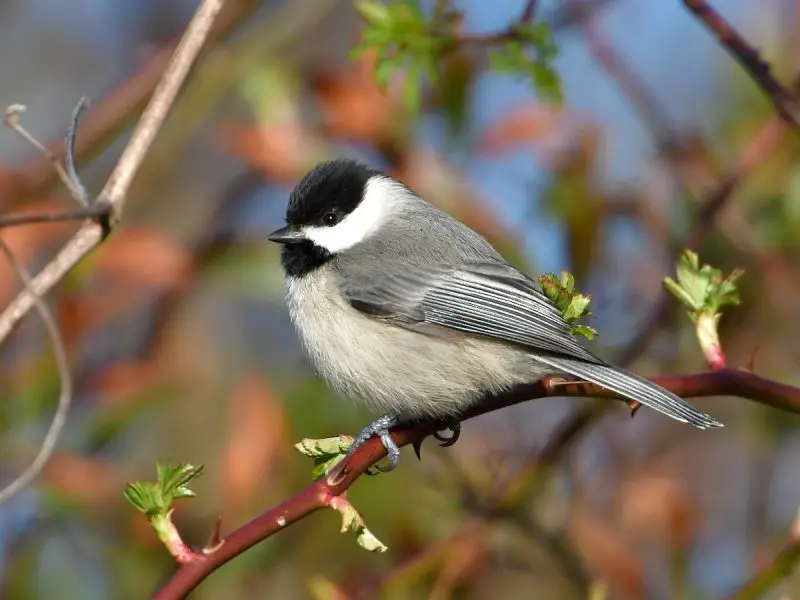
Carolina Chickadees are small, energetic birds measuring only about 4.5–5 inches long, with a wingspan of 6–8 inches. They are identifiable by their black cap and bib, white cheeks, grayish upperparts, and lighter undersides. Their tiny, rounded bodies and short bills make them quite charming to watch.
These birds are social and curious, often traveling in mixed-species flocks during the fall and winter. Carolina Chickadees are common at feeders, especially those with suet, sunflower seeds, or peanuts. They are agile, often hanging upside down as they forage.
In Kentucky, Carolina Chickadees inhabit deciduous forests, wooded suburbs, and backyards with mature trees. They nest in cavities and may use nest boxes. Their familiar “chick-a-dee-dee-dee” call and high-pitched songs help them stay in contact with flockmates.
Tufted Titmouse
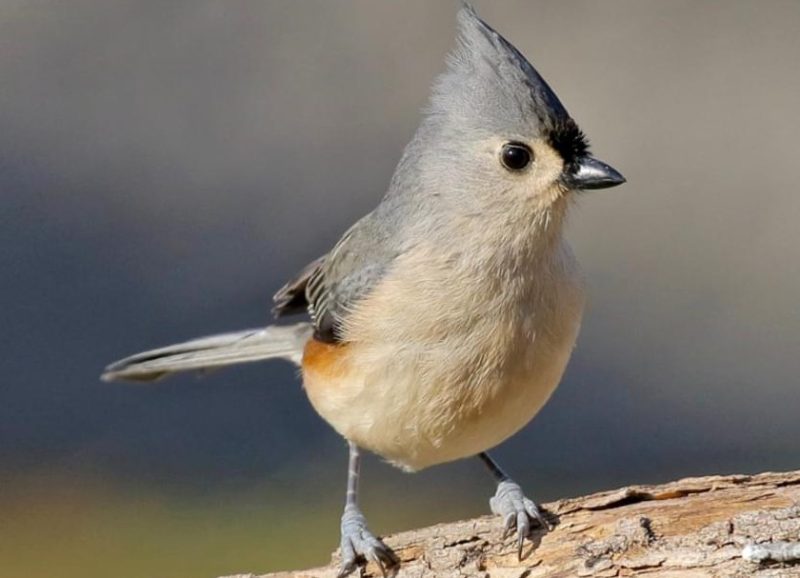
The Tufted Titmouse is a compact songbird with a soft gray body, white face, and distinct pointed crest atop its head. A small black patch appears just above its beak, and its sides often have a wash of peachy or buff color. It measures around 6–6.5 inches in length with an 8–10 inch wingspan.
These birds are common in Kentucky’s woodlands and residential areas. They frequently visit feeders and favor sunflower seeds, suet, and peanuts. Tufted Titmice are known for their quick, darting movements and are often seen grabbing a seed and flying off to eat it in privacy.
They typically live in deciduous or mixed forests but readily adapt to suburban yards and parks. In Kentucky, they can be spotted year-round. Their clear, whistled “peter-peter-peter” song is a familiar sound in the region, especially during spring and early summer.
Carolina Wren
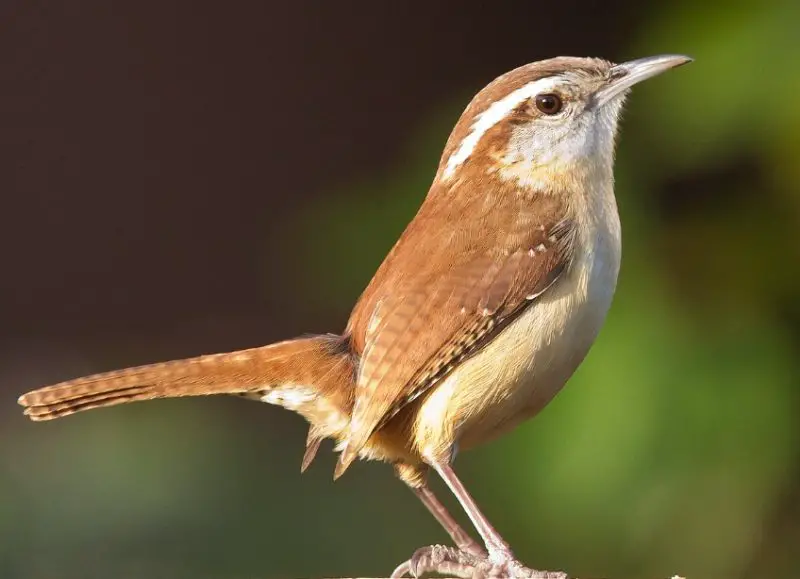
Carolina Wrens are small but feisty birds with a rich cinnamon-brown color on the upper body and warm buff underparts. One of their most distinctive features is the bold white stripe above each eye. These wrens have slightly curved bills and hold their tails upright when active.
Measuring about 5.5 inches long with a wingspan of 7–9 inches, they are energetic and vocal. Carolina Wrens are often heard before they’re seen, thanks to their loud and varied songs. They are insectivores but will visit feeders for suet, especially during colder months.
In Kentucky, they inhabit brushy yards, thickets, and areas with dense vegetation. They are year-round residents and nest in cavities, hanging baskets, or even mailboxes. Their adaptability makes them frequent backyard visitors, particularly where natural cover is present.
American Robin
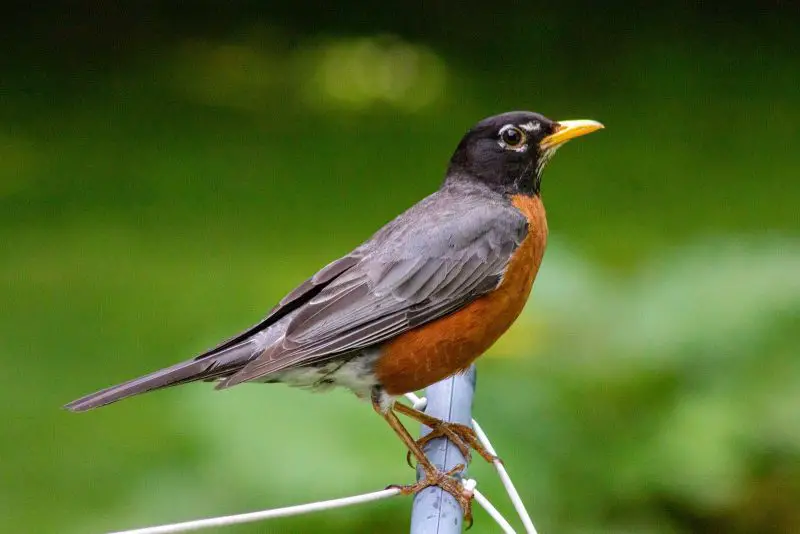
The American Robin is a familiar sight in Kentucky, especially during spring and summer. These medium-sized thrushes are best known for their rusty-red breast, gray upperparts, and cheerful song. Both males and females share similar coloring, although males may appear slightly brighter.
They measure about 9–11 inches in length with a wingspan of 12–15 inches. Robins forage primarily on the ground, often seen hopping across lawns in search of earthworms. During the colder months, they switch to a diet of berries and fruit and may gather in large flocks.
Robins prefer open woodlands, gardens, and suburban lawns. In Kentucky, they breed across the state and are among the first birds to start nesting each spring. Their melodic dawn chorus is a sure sign that warmer weather has arrived.
Blue Jay
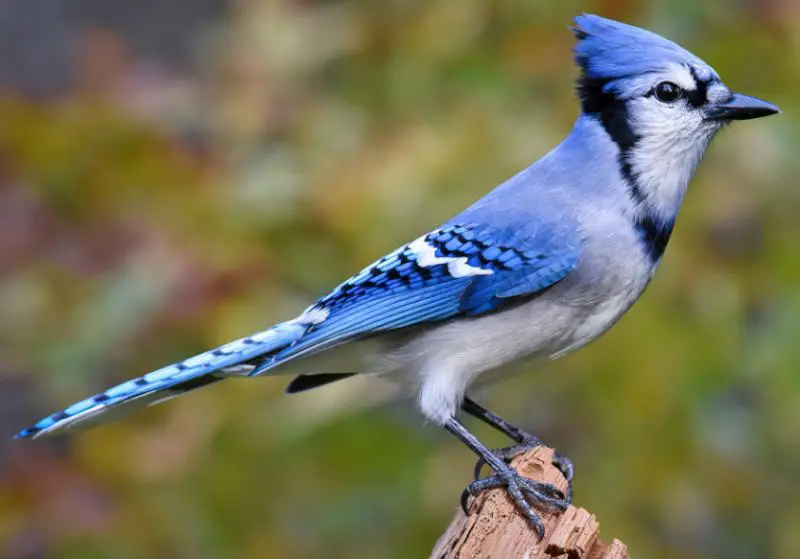
The Blue Jay is one of the most recognizable birds in Kentucky due to its vivid blue plumage, white chest, and striking black markings on the face and wings. These birds are large for songbirds, measuring about 9–12 inches long with a wingspan of 13–17 inches. Their prominent crest and harsh “jay jay” call make them stand out both visually and audibly.
Highly intelligent and curious, Blue Jays are known for mimicking the calls of hawks and hiding food such as peanuts and acorns to eat later. They are frequent visitors at backyard feeders, particularly when peanuts (in or out of the shell), corn, or sunflower seeds are offered. Their bold behavior often drives away smaller birds.
In Kentucky, Blue Jays are year-round residents and thrive in a variety of habitats including woodlands, forest edges, and suburban yards. They are often spotted traveling in family groups or small flocks. These birds also play an important ecological role by dispersing seeds, especially oak acorns.
American Goldfinch
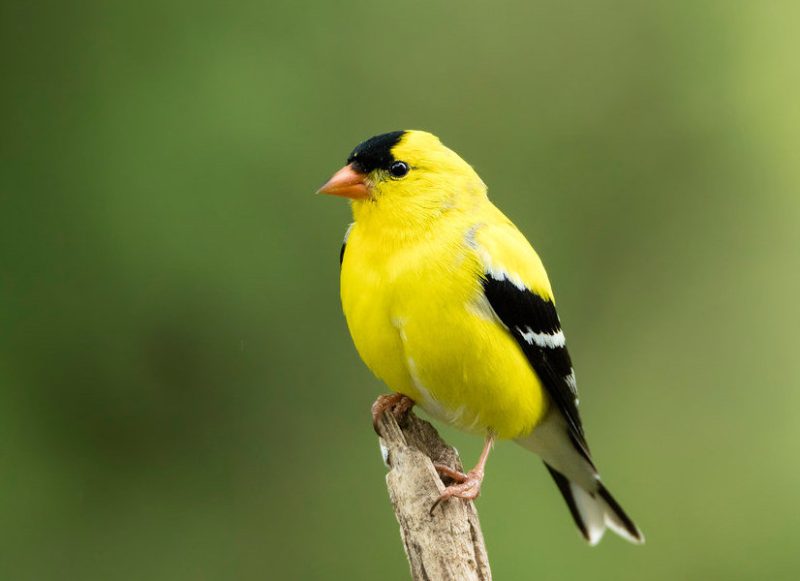
The American Goldfinch is a small, brightly colored finch that is especially vibrant during the summer. Males sport bright yellow plumage with black wings and a black cap, while females are more subdued in yellowish-olive tones. In winter, both sexes turn a duller olive-brown with blackish wings. They are about 4.5–5 inches long with a wingspan of 7.5–8.5 inches.
Goldfinches are energetic and acrobatic, often seen flitting among flowers and feeders. They feed primarily on seeds, with a strong preference for thistle (nyjer) and sunflower seeds. Their undulating flight pattern and cheerful “per-chick-o-ree” call make them easy to identify in flight.
In Kentucky, American Goldfinches are present year-round, though they are more noticeable in summer due to their brilliant breeding plumage. They frequent weedy fields, gardens, and backyard feeders. Unlike most songbirds, they nest late in the summer, coinciding with peak seed availability.
Downy Woodpecker
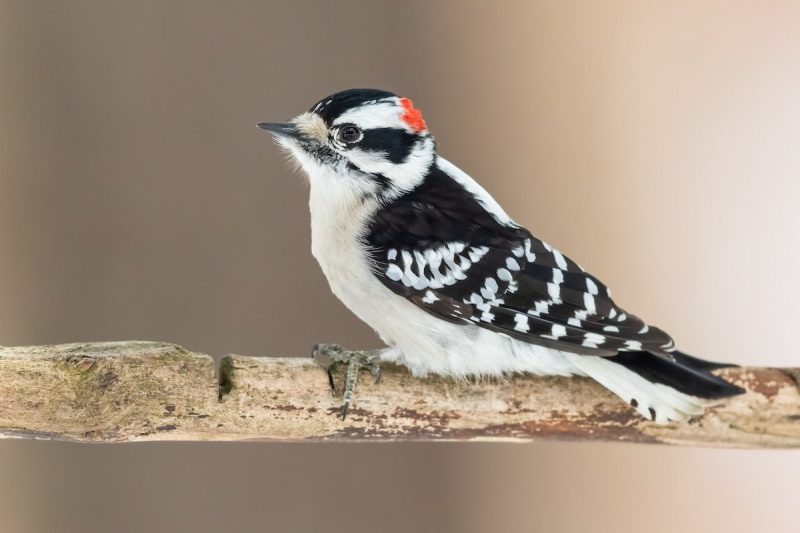
The Downy Woodpecker is the smallest woodpecker in North America, measuring about 5.5–6.5 inches in length with a wingspan of 9–12 inches. They have a black-and-white pattern, with a checkered back, white underside, and small black bill. Males have a small red patch on the back of the head, which females lack.
Downy Woodpeckers are curious and tame, often visiting suet feeders in Kentucky backyards. They also forage on tree trunks and branches, picking at insects and larvae hidden under the bark. Their sharp “pik” call and short drumming bursts are familiar woodland sounds.
They are year-round residents in Kentucky and inhabit a variety of wooded areas, from deep forests to suburban parks and yards. These adaptable birds often use dead limbs for nesting and roosting, and will occasionally use nest boxes if available.
Red-bellied Woodpecker
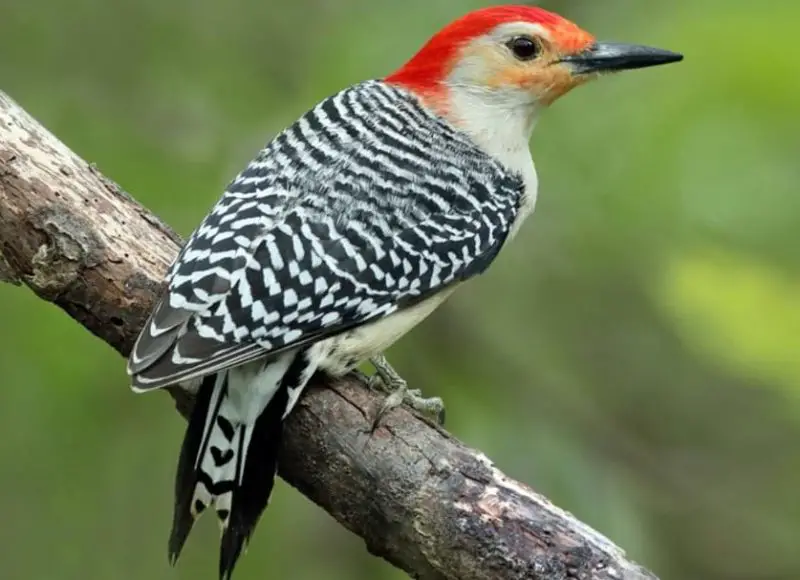
The Red-bellied Woodpecker is a medium-sized woodpecker with a distinctive appearance. It has a pale, slightly reddish belly (often hard to see), black-and-white barred back, and a vivid red crown that extends from the bill to the nape in males. Females have a red nape and gray crown. They are about 9–10.5 inches long with a wingspan of 15–18 inches.
These birds are frequent visitors to backyard feeders and are especially fond of suet, peanuts, and sunflower seeds. They also forage in trees for insects and may occasionally drum on metal surfaces or wooden structures. Their rolling “churr” call is a common sound in Kentucky woodlands.
Red-bellied Woodpeckers live in forests, groves, and suburban yards across Kentucky. They nest in tree cavities and are known to return to the same sites year after year. Their ability to adapt to both rural and urban environments has helped their population remain stable throughout the region.
Mourning Dove
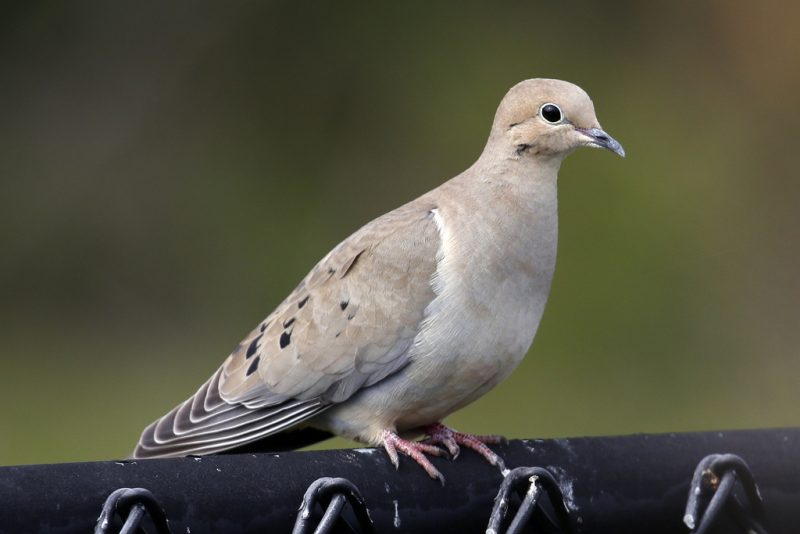
Mourning Doves are soft, sleek birds with pale brown to gray bodies, long pointed tails with white edges, and small dark eyes. They measure around 9–13 inches in length and have a wingspan of 17–18 inches. Their gentle appearance and calm demeanor make them one of the most peaceful backyard birds in Kentucky.
They often feed on the ground, walking gracefully as they pick up seeds. Mourning Doves prefer millet, cracked corn, and sunflower seeds, usually feeding beneath bird feeders. Their soft, sorrowful “coo-oo-oo” call is a familiar background sound, especially in the early morning and evening.
In Kentucky, Mourning Doves are found statewide in open habitats including fields, lawns, and suburban areas. They are year-round residents and breed multiple times in a season. Their cup-shaped nests are often seen on tree branches, ledges, or even in hanging flower pots.
House Finch
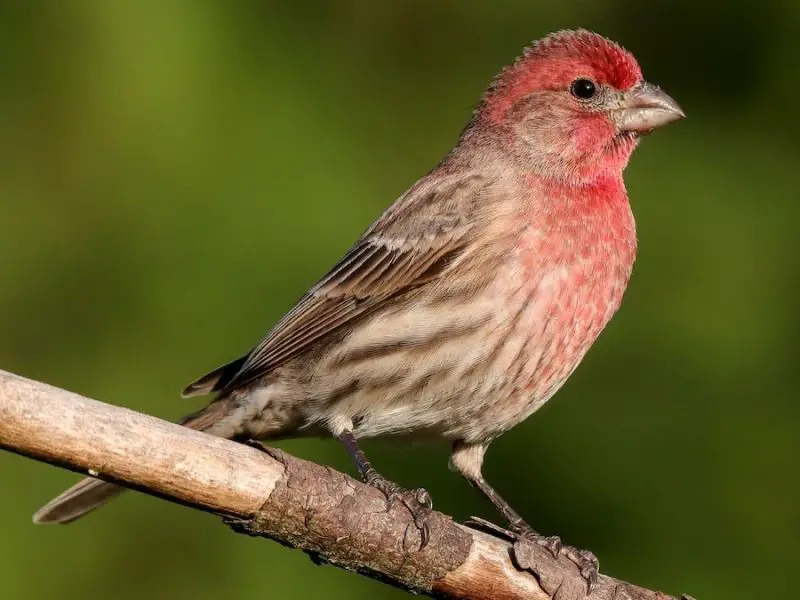
House Finches are small, sociable birds often seen in flocks around feeders. Males are recognizable by their bright red foreheads, throats, and chests, which contrast with their brown-streaked bodies. Females lack the red coloring and are entirely brown and streaked, making them a bit trickier to identify.
They measure about 5–6 inches in length with a wingspan of 8–10 inches. House Finches are frequent visitors to backyard feeders, where they especially enjoy sunflower seeds and millet. They are vocal birds, often filling the air with cheerful, warbling songs and sharp “cheep” calls.
In Kentucky, House Finches are common year-round in urban, suburban, and rural areas. They nest in shrubs, building ledges, and hanging planters. Originally native to the western United States, they were introduced in the east and have since spread widely, adapting easily to human environments.
Purple Finch
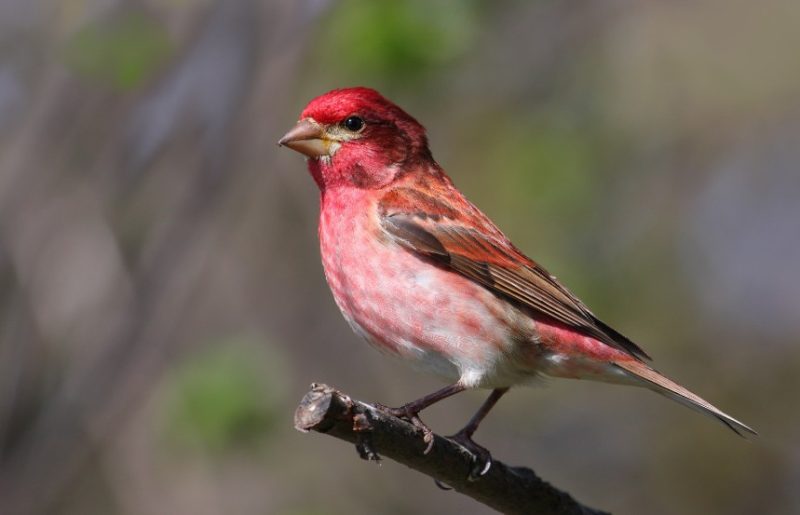
Purple Finches are similar in size and shape to House Finches but are less common in Kentucky. Males are covered in a rich raspberry-red wash over the head, chest, and back, with streaky flanks and a notched tail. Females are brown with strong facial markings, including a white eyebrow and darker cheek stripe.
These birds measure about 5.5–6 inches long with a wingspan of 9–10 inches. They prefer conifer seeds, buds, and berries, but will readily visit backyard feeders in winter, especially when sunflower seeds are available. Their musical warble is richer and more complex than the House Finch’s.
In Kentucky, Purple Finches are typically winter visitors, moving south during colder months. They favor forested areas and wooded suburbs and may appear in flocks during irruption years when food is scarce further north. Their presence at feeders is always a seasonal delight for birdwatchers.
Eastern Bluebird
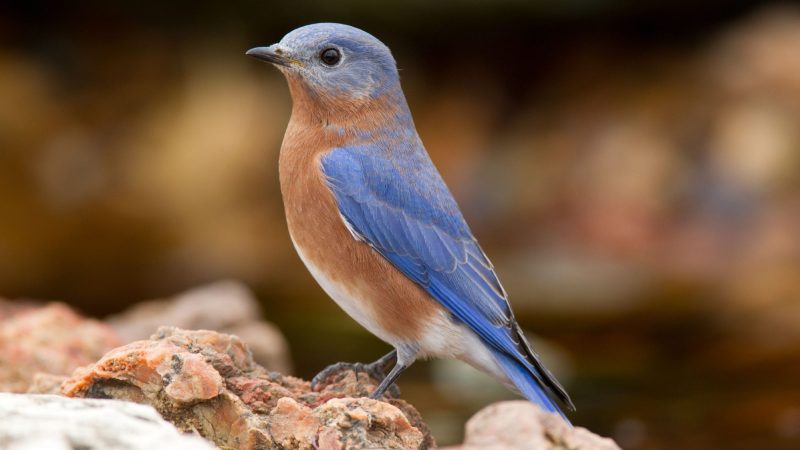
The Eastern Bluebird is a beloved songbird in Kentucky, known for its stunning coloration. Males display vibrant royal blue plumage on the back and wings with a rusty orange chest and white belly. Females are paler, with more subdued blue and rusty tones. They are about 6.5–7 inches long with a wingspan of 9.5–12 inches.
Eastern Bluebirds are cavity-nesters and readily use nest boxes placed in open areas. They feed primarily on insects during the warmer months but switch to berries and fruits in the winter. Their gentle warbling song and soft “chur-lee” calls are often heard in fields and gardens.
In Kentucky, they are year-round residents and are commonly seen in orchards, parks, and grassy meadows. Conservation efforts such as providing nest boxes have significantly helped their populations rebound after past declines due to habitat loss and competition from non-native species.
White-breasted Nuthatch
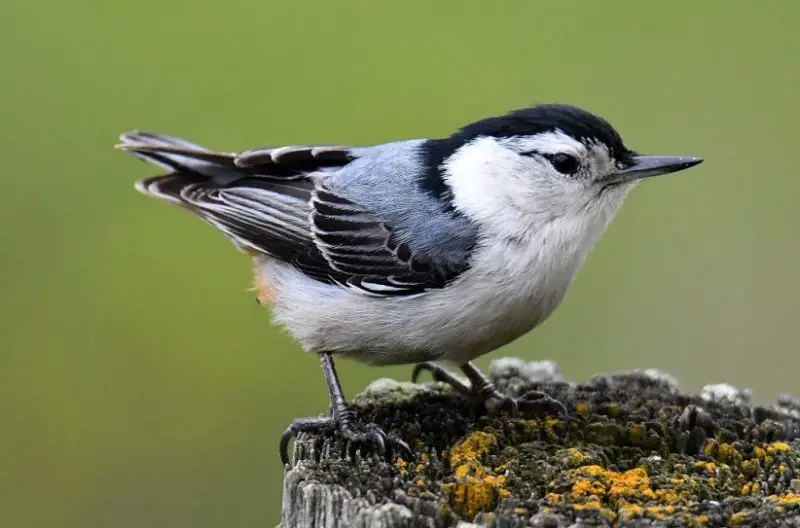
White-breasted Nuthatches are agile, tree-loving birds known for their ability to move headfirst down tree trunks. They have a clean white face and underparts, a black cap, and gray-blue upperparts. A slight rusty patch may appear on the lower belly. These birds are compact, measuring about 5–6 inches long with a wingspan of 8–11 inches.
They often forage by probing bark crevices for insects and seeds and will wedge food into cracks to eat later. White-breasted Nuthatches also frequent feeders, especially those offering suet, sunflower seeds, or peanuts. Their nasal “yank-yank” call is easy to recognize.
These birds live year-round in Kentucky’s mature deciduous and mixed forests, but they’re also common in wooded backyards and parks. They are cavity nesters and may use birdhouses if natural tree holes are unavailable. Their distinctive behavior and bold presence make them favorites among backyard birders.
Brown-headed Cowbird

The Brown-headed Cowbird is a stocky blackbird species with a unique and controversial breeding strategy. Males have glossy black bodies with a contrasting chocolate-brown head, while females are plain gray-brown all over. They measure about 7–8.5 inches long with a wingspan of 12–15 inches.
Cowbirds typically forage on the ground, often under feeders, where they eat seeds and grains. However, they are best known for brood parasitism—they lay their eggs in the nests of other bird species, leaving the host birds to raise their young. This behavior can negatively impact native songbirds.
In Kentucky, Brown-headed Cowbirds are common during spring and summer in open habitats like pastures, fields, and suburban lawns. Though widespread, their reproductive habits are closely monitored by conservationists, especially in areas where they affect endangered host species.
Chipping Sparrow
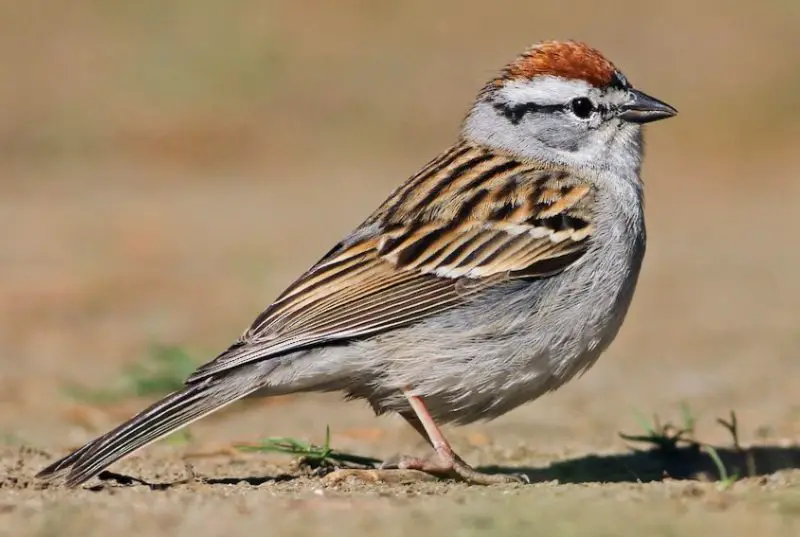
The Chipping Sparrow is a small and active sparrow, recognized by its clean gray breast, rusty-red cap, and bold black eye line. In breeding plumage, the contrast is striking, while in winter, the cap turns a duller brown and the overall appearance becomes more streaked. They are about 5 inches long with a wingspan of 8–9 inches.
These sparrows are frequent visitors to feeders, especially those offering millet, cracked corn, and sunflower chips. They tend to feed on the ground or low platforms and often forage in small flocks. Their sharp “chip” call gives them their name, and their song is a rapid, dry trill.
Chipping Sparrows are common throughout Kentucky during the breeding season, favoring open woodlands, grassy lawns, and suburban gardens. In fall, many migrate south, though a few may overwinter in the region depending on the weather. They build small cup-shaped nests in shrubs or low tree branches.
Song Sparrow
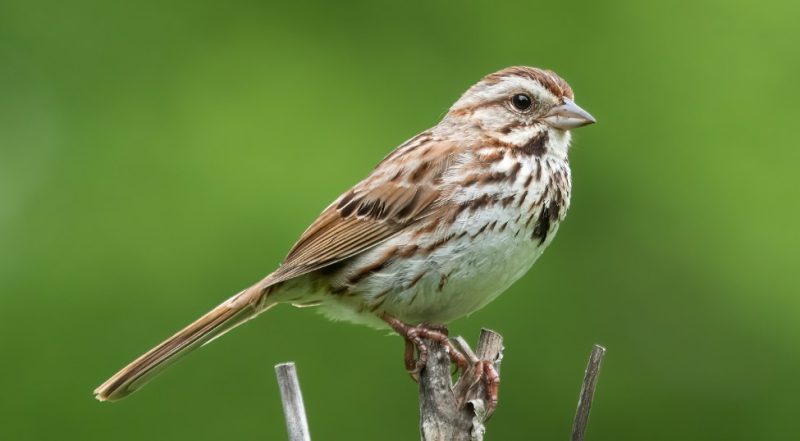
The Song Sparrow is a medium-sized brown sparrow known for its heavily streaked plumage and prominent dark spot in the center of its chest. It has a rounded tail and a slightly rounded crown with subtle gray and brown tones. Adults measure about 5.5–7 inches long with a wingspan of 7–9 inches.
True to its name, this sparrow is celebrated for its sweet and varied song, which often begins with a few clear notes followed by a musical trill. They forage low in shrubs or on the ground, feeding on seeds and insects. During winter, they readily visit feeders for millet and sunflower seeds.
Song Sparrows are found across Kentucky year-round, especially near thickets, brushy fields, and wetland edges. Their adaptability to different habitats, including suburban yards with dense cover, makes them one of the most widespread and familiar sparrow species in the state.
Dark-eyed Junco
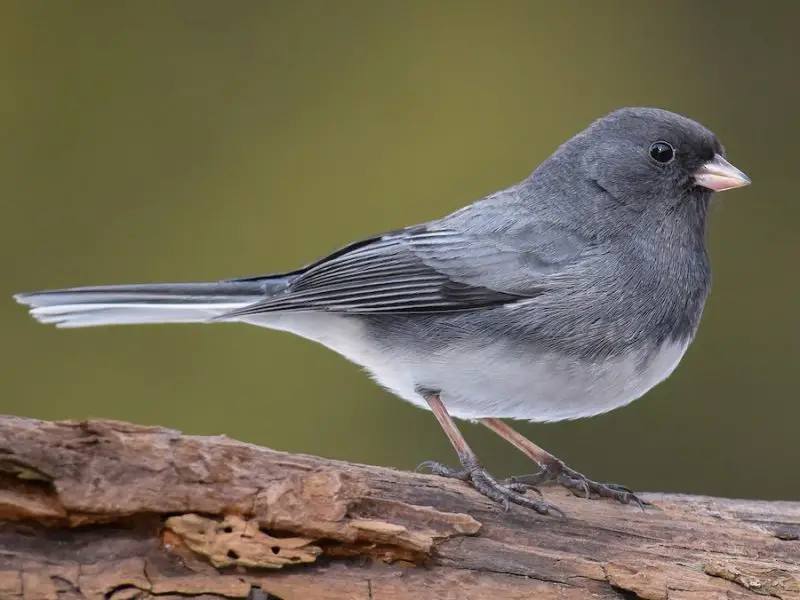
Dark-eyed Juncos are small, plump songbirds with slate-gray upperparts, white bellies, and pale pink bills. Males tend to be darker, while females and juveniles have more brownish-gray tones. They measure around 5.5–6.5 inches in length with a wingspan of 7–10 inches.
These birds are primarily winter visitors in Kentucky, often arriving in large numbers from the north. They forage on the ground beneath feeders, favoring millet, cracked corn, and sunflower seeds. Their hopping gait and flashing white outer tail feathers make them easy to spot.
In Kentucky, juncos prefer forest edges, fields, and backyards with ample ground space and nearby shrubs for cover. They typically migrate northward to breed in Canada and the northern U.S. By early spring, their numbers decline as they begin their return migration.
Northern Mockingbird
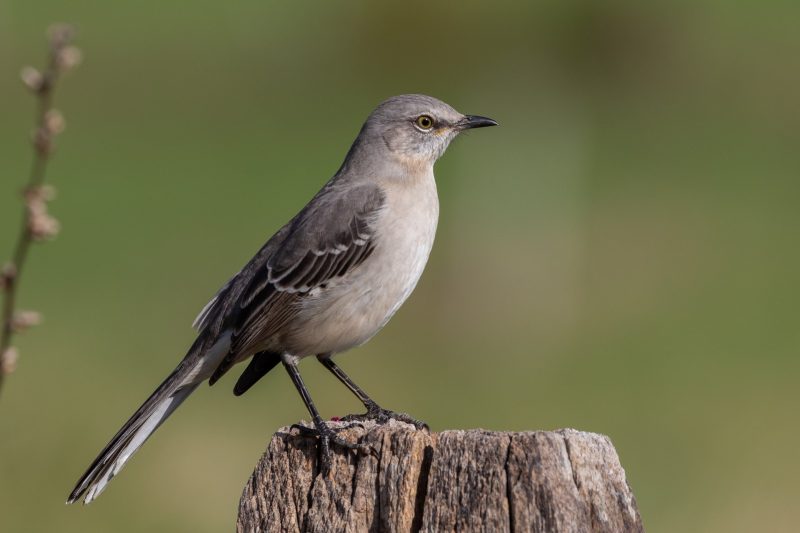
The Northern Mockingbird is a sleek, medium-sized songbird with gray upperparts, pale underparts, and bold white wing patches visible in flight. They measure about 8–10 inches long with a wingspan of 12–14 inches. Their long tail and upright posture give them a proud and alert appearance.
Mockingbirds are famous for their vocal abilities, often mimicking the calls of other birds, insects, and even mechanical noises. They sing frequently, especially during breeding season, sometimes continuing well into the night. They are territorial and will aggressively defend their nesting areas.
In Kentucky, Northern Mockingbirds are year-round residents found in suburbs, farmland, parks, and urban yards. They prefer open areas with scattered shrubs or trees and are often seen perched conspicuously while singing or chasing away intruders. They feed on insects, berries, and fruit.
European Starling
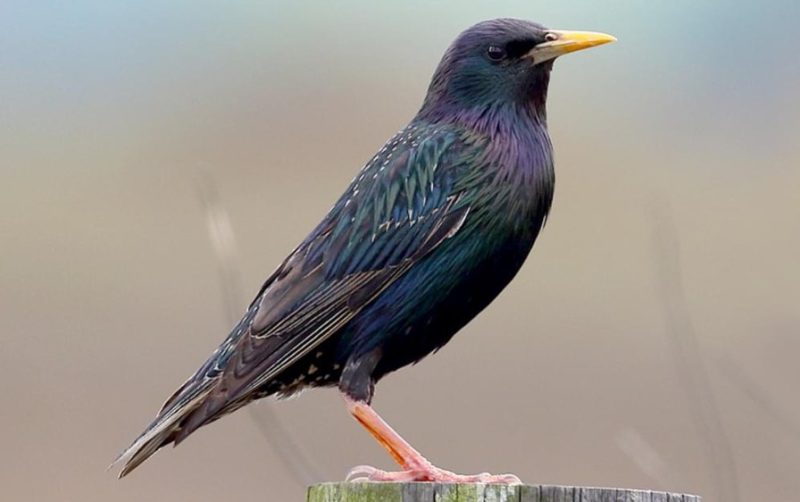
European Starlings are glossy, blackish birds with a metallic sheen and pale speckles, especially noticeable in winter. During breeding season, their plumage becomes sleeker and more iridescent, with yellow bills replacing their winter-dark ones. They are medium-sized birds, about 7.5–9 inches long with a wingspan of 12–16 inches.
These birds are highly social and often form large flocks, especially in fall and winter. At feeders, they can be aggressive and dominant, driving off smaller species. They eat a wide variety of foods, including insects, fruit, seeds, and scraps. Their vocalizations include whistles, squawks, and imitations of other birds.
Introduced from Europe in the 1800s, European Starlings have spread across North America, including all of Kentucky. They adapt well to urban and rural settings and frequently nest in cavities, including vents, eaves, and nest boxes intended for other species. While beautiful in flight, they are often considered pests due to their invasive nature and competitive behavior.
Red-winged Blackbird
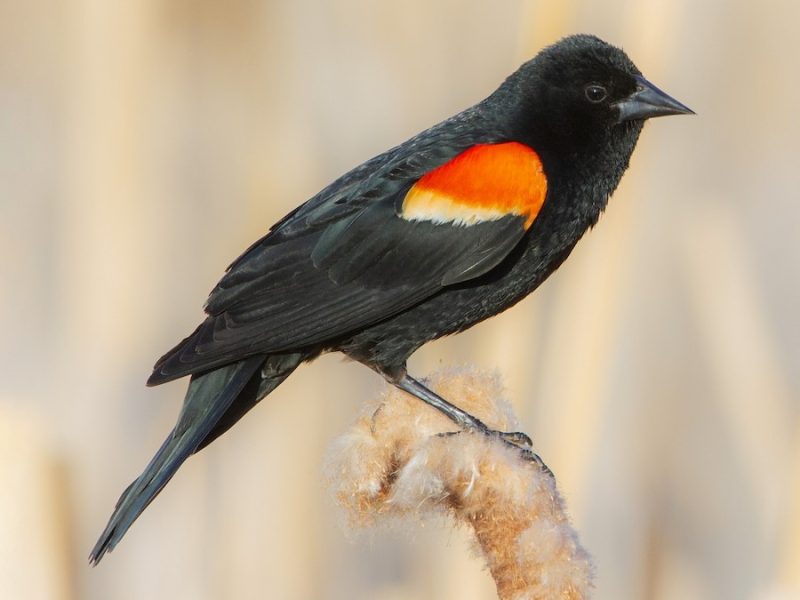
Red-winged Blackbirds are among the most striking blackbirds in Kentucky. Males are entirely black with vivid red and yellow patches on their shoulders, called epaulets, which they flash while calling or displaying. Females look very different, with brown-streaked plumage and a slightly curved bill. They measure about 7–9.5 inches in length with a wingspan of 12–16 inches.
These birds are known for their loud, buzzy “conk-la-ree!” song and their bold, territorial behavior, especially during nesting season. While they are most commonly associated with marshes and wetlands, Red-winged Blackbirds will also visit backyard feeders for cracked corn and sunflower seeds, particularly in early spring and late summer.
In Kentucky, they are widespread breeders in wet meadows, cattail marshes, and roadside ditches. During migration and winter, they form large flocks and may be seen in open fields and agricultural areas. Their adaptability to different food sources and habitats helps maintain their strong presence throughout the state.
Common Grackle
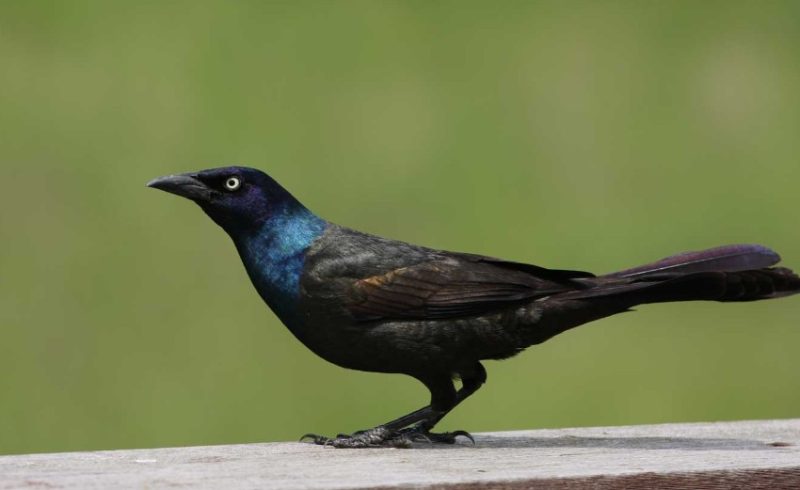
The Common Grackle is a large, long-tailed blackbird with a glossy, iridescent sheen that may appear purple, blue, or green in sunlight. Their pale, yellowish eyes give them a piercing look, and their overall size—about 11–13 inches long with a wingspan of 14–18 inches—makes them one of the largest songbirds at feeders.
Grackles are opportunistic feeders, often traveling in noisy flocks and dominating feeders with their size and numbers. They consume seeds, grains, insects, and even small vertebrates, and are known for their loud, metallic-sounding calls and squeaks. They walk confidently on lawns and parking lots, searching for food.
In Kentucky, Common Grackles breed in open woodlands, farmlands, and towns. They often nest in colonies near water and return to southern parts of the state in winter. Though considered a nuisance by some due to their aggressive feeding habits and large roosting flocks, they remain a widespread and adaptable species.
House Sparrow
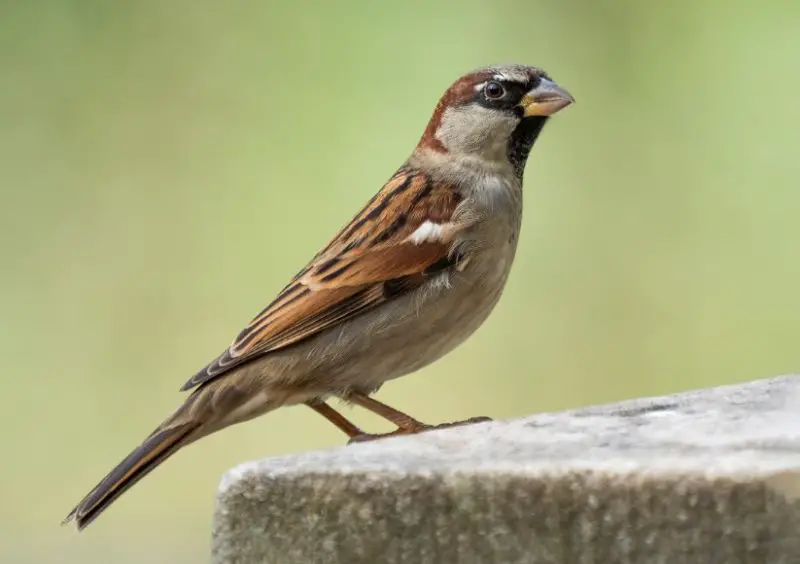
House Sparrows are small, chunky songbirds with short tails and thick bills. Males have gray heads, black bibs, and chestnut-brown backs with black streaks. Females and juveniles are duller, with more uniform brown and gray tones. They measure about 6–6.5 inches long with a wingspan of 7.5–9.5 inches.
Originally introduced from Europe in the 1800s, House Sparrows have become one of the most widespread birds in urban and suburban areas across Kentucky. They are commonly seen at feeders, especially those offering bread crumbs, millet, and other grains. These sparrows are aggressive and often outcompete native birds for food and nesting sites.
In Kentucky, House Sparrows nest in cavities, including eaves, vents, and birdhouses, especially near human structures. They do not migrate and are present year-round. Although not native, they are deeply embedded in the local avian community and are often among the first birds noticed in city parks and neighborhoods.
Indigo Bunting
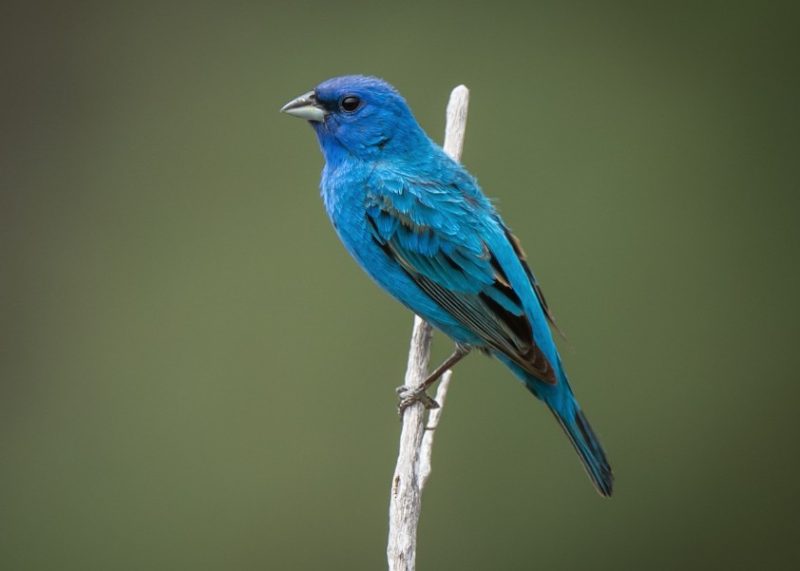
The Indigo Bunting is a small but stunning songbird, especially when seen in full summer sunlight. Breeding males are a brilliant, deep blue all over, while females and non-breeding males are brown with subtle blue highlights. These birds are about 5–5.5 inches long with a wingspan of 7.5–8.5 inches.
They sing a sweet, musical warble from high perches and are more often heard before being seen. Indigo Buntings feed on seeds, berries, and insects, and while they are more common in rural and semi-open areas, they will visit feeders offering millet or nyjer seed. Their flight is fluttery and quick, often low to the ground.
In Kentucky, Indigo Buntings breed widely in brushy fields, forest edges, and along rural roadsides. They migrate south to Central America for winter, returning in late spring. Their vivid coloring and cheerful songs make them a seasonal favorite among birdwatchers and gardeners.
Ruby-throated Hummingbird
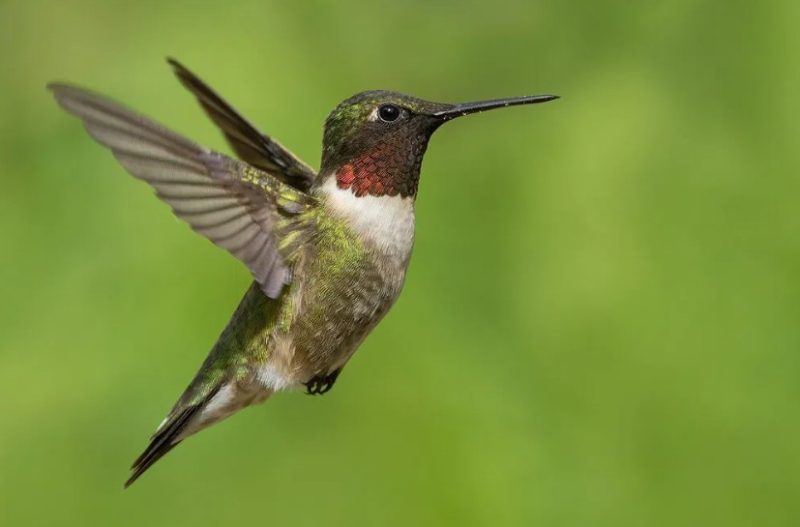
The Ruby-throated Hummingbird is the only hummingbird species that breeds regularly in Kentucky. Males have shimmering emerald-green backs and a vibrant ruby-red throat that appears black in some lighting. Females lack the red throat and are mostly green and white. They measure just 3–3.5 inches long with a wingspan of 4–4.5 inches.
These birds are famous for their rapid wingbeats and ability to hover while feeding. They feed on nectar from flowers and hummingbird feeders, as well as small insects and spiders. Ruby-throated Hummingbirds are fiercely territorial and often chase other hummingbirds away from feeding spots.
In Kentucky, they arrive in spring and stay through early fall, favoring gardens with tubular flowers and wooded areas with nearby water. They are migratory and spend the winter in Central America. Providing clean nectar feeders and planting native blooms can help attract them to your yard during the warmer months.
Eastern Towhee
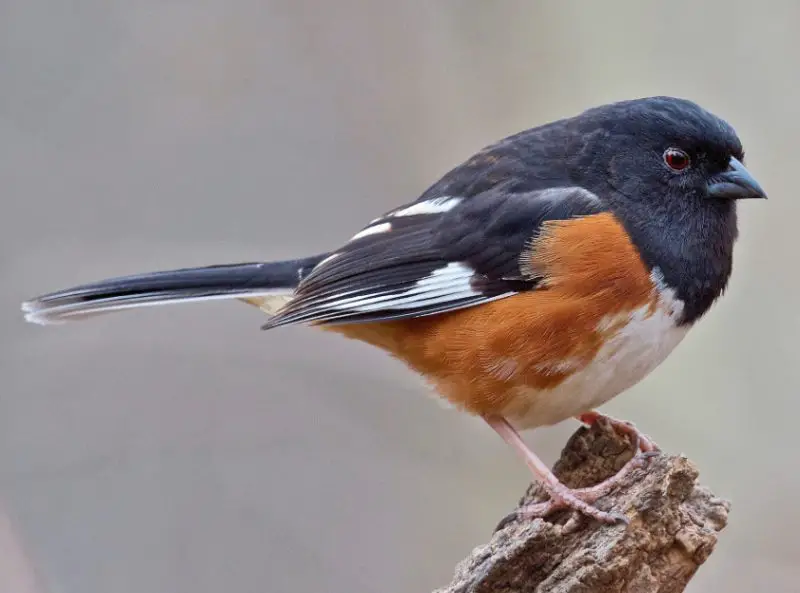
The Eastern Towhee is a boldly patterned songbird, with males displaying black upperparts, rufous-orange flanks, and a clean white belly. Females are similar in pattern but are rich brown instead of black. Both sexes have striking red eyes and a thick, sparrow-like bill. They measure about 7–8.5 inches long with a wingspan of 9.5–11 inches.
These birds are often heard before seen, calling out their signature “drink-your-tea!” song or rustling noisily in leaf litter as they forage. Eastern Towhees feed on insects, seeds, and berries, scratching the ground with a two-footed backward hop to uncover food. They may visit low platform feeders offering sunflower seeds or cracked corn.
In Kentucky, Eastern Towhees are year-round residents in brushy woodlands, forest edges, and overgrown fields. They prefer dense vegetation for nesting and foraging and are often seen hopping near thickets or along fence lines. Their shy, ground-dwelling habits make them less visible, but their calls and songs often give them away.
Baltimore Oriole
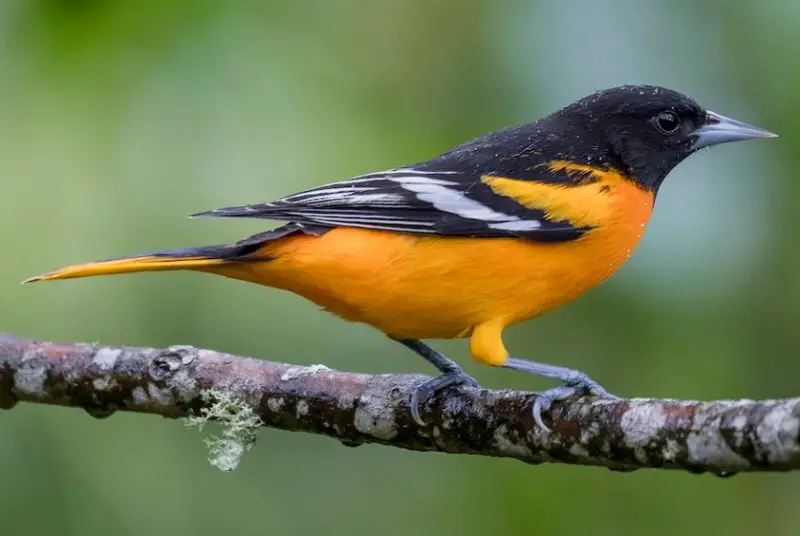
The Baltimore Oriole is one of Kentucky’s most visually stunning summer visitors. Adult males are bright orange with black heads, backs, and wings marked with white wing bars. Females and immature birds are yellow-orange with grayish backs and wings. They are medium-sized songbirds, measuring about 6.5–8 inches long with a wingspan of 9–12 inches.
These orioles are nectar and fruit lovers, frequently visiting feeders offering orange slices, grape jelly, or sugar-water nectar. Their flutelike song and rich whistles brighten spring mornings. They also eat insects, especially caterpillars and beetles, which they glean from tree branches.
Baltimore Orioles migrate to Central and South America for the winter and return to Kentucky in late April or early May to breed. They nest high in trees, weaving elaborate hanging nests from plant fibers. Look for them in open woodlands, parks, and backyards with mature trees and fruit-bearing plants.
Cedar Waxwing
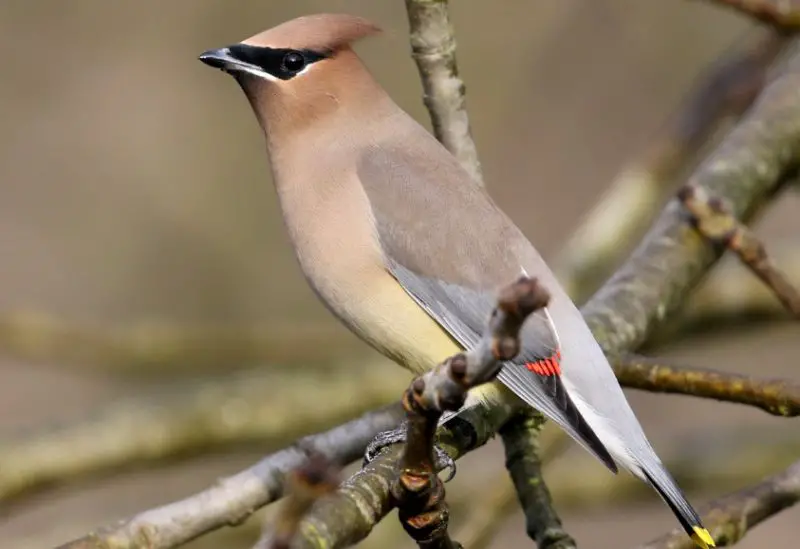
Cedar Waxwings are sleek, elegant birds with silky, pale brown plumage that fades to gray on the wings, accented by a black eye mask and a yellow-tipped tail. Some individuals also sport small red wax-like tips on their wing feathers. They are about 6–7 inches long with a wingspan of 8.5–12 inches.
Highly social, these birds often travel in flocks and are known for passing berries from bird to bird. Their diet consists mainly of fruit, especially cedar berries, serviceberries, dogwood, and other native species. Their high-pitched, lisping calls often alert observers to their presence before they are seen.
In Kentucky, Cedar Waxwings are seen year-round but are more prominent in fall and winter when berries are abundant. They prefer open woodlands, orchards, and suburban areas with fruiting trees and shrubs. Waxwings are nomadic and may appear in large numbers one day and vanish the next.
Brown Thrasher
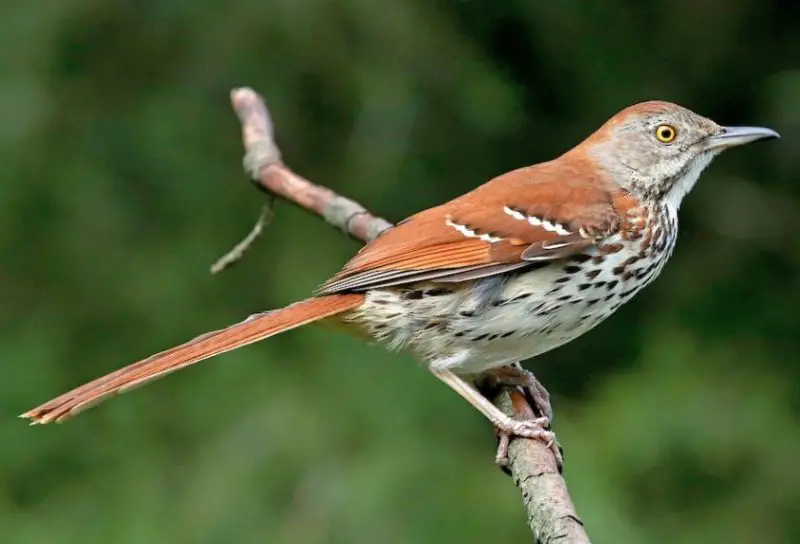
The Brown Thrasher is a long-bodied bird with rich reddish-brown upperparts, heavily streaked white underparts, and bright yellow eyes. Its long, slightly curved bill and long tail give it a distinctive profile. Adults measure about 9–12 inches long with a wingspan of 11–13 inches.
Known for their vocal talents, Brown Thrashers can sing over 1,000 different song phrases, often mimicking other species. They forage on the ground by flipping leaves and debris with their bills in search of insects, seeds, and small fruits. Though shy, they may visit low feeders or ground trays.
In Kentucky, they are widespread in brushy fields, forest edges, hedgerows, and dense thickets. Thrashers are year-round residents in many parts of the state, though some migrate further south in winter. Their loud, varied song is often heard in spring from high perches in dense vegetation.
Killdeer
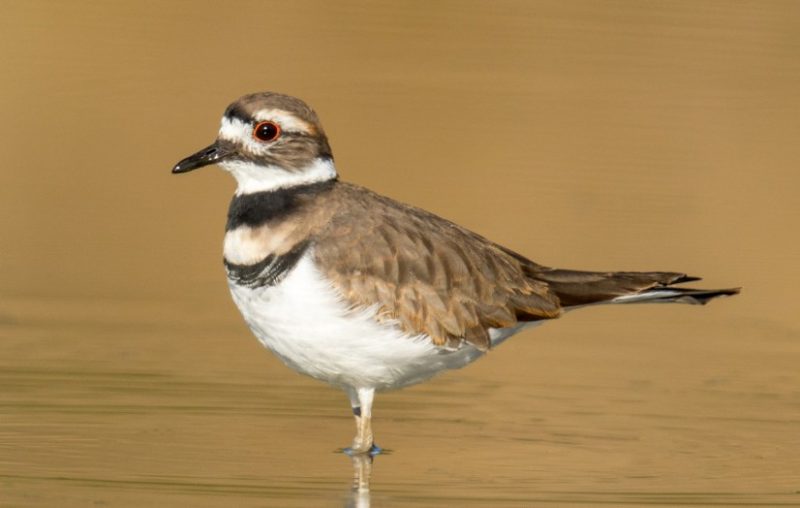
Killdeer are slender, long-legged plovers with a brown back, white belly, and two bold black bands across the chest. Their most distinctive feature is their loud, piercing “kill-deer” call, which gives them their name. They are about 8–11 inches long with a wingspan of 18–21 inches.
Unlike most shorebirds, Killdeer are often found far from water, frequenting open areas such as gravel driveways, lawns, agricultural fields, and golf courses. They feed on insects and other small invertebrates, running in quick spurts and stopping to peck at the ground.
In Kentucky, Killdeer are common spring through fall, with some overwintering in the southern part of the state. They nest directly on the ground, often in gravel or bare soil, and are famous for their “broken wing” display to distract predators from their nests. Their loud calls and bold behavior make them easy to identify even in non-coastal settings.
FAQ About Backyard Birds in Kentucky
What are the most common backyard birds in Kentucky?
Kentucky hosts a wide variety of backyard birds throughout the year. Some of the most common species include the Northern Cardinal, Carolina Chickadee, Tufted Titmouse, American Robin, and Blue Jay. These birds are often spotted at feeders and in residential areas, especially where trees and shrubs are abundant.
When is the best time to see backyard birds in Kentucky?
While many birds are present year-round, spring and summer offer the most diversity due to migratory species returning to breed. Birds like the Baltimore Oriole and Ruby-throated Hummingbird arrive in late spring, while others, such as Dark-eyed Juncos, are winter visitors. Early morning is generally the best time for birdwatching.
What should I feed backyard birds in Kentucky?
Different species prefer different foods. Sunflower seeds, suet, peanuts, and millet are excellent choices. Orioles enjoy fruit and jelly, while hummingbirds prefer sugar-water nectar. Always use clean feeders and fresh food to attract birds safely.
How can I attract more birds to my backyard?
To attract a variety of birds, offer multiple types of feeders and food sources. Providing fresh water, native plants, shrubs for cover, and nesting boxes can also encourage birds to visit and stay. Avoid using pesticides, which may harm birds and reduce the number of insects they rely on.
Are hummingbirds common in Kentucky backyards?
Yes, the Ruby-throated Hummingbird is the only regularly occurring species in Kentucky. They typically arrive in late April or early May and stay through the summer. Hummingbirds are drawn to nectar feeders and tubular red flowers such as bee balm and trumpet vine.
What birds are only seen in Kentucky during certain seasons?
Many birds are migratory and visit Kentucky only during certain parts of the year. Dark-eyed Juncos and White-throated Sparrows are seen in winter, while Baltimore Orioles, Indigo Buntings, and Eastern Bluebirds are more common in spring and summer. Migration periods in spring and fall also bring a wider variety of species through the state.
Do any backyard birds in Kentucky mimic other birds’ songs?
Yes, the Northern Mockingbird and the Brown Thrasher are known for their impressive mimicry skills. The mockingbird, in particular, can imitate other birds, mechanical noises, and even car alarms. Their long and varied songs are often heard throughout the day and sometimes even at night.
Are there any invasive bird species in Kentucky?
Yes, two of the most common non-native birds in Kentucky are the House Sparrow and the European Starling. Both were introduced from Europe and have become widespread. These birds can be aggressive at feeders and may compete with native birds for nesting sites.
Is it okay to feed birds year-round in Kentucky?
Yes, feeding birds year-round is fine as long as feeders are kept clean and filled with appropriate food. During winter, food is especially valuable when natural resources are scarce. In summer, avoid feeding moldy or spoiled food, and provide clean water during dry spells.
Can I help birds nest in my yard?
Absolutely! Installing nest boxes for birds like Eastern Bluebirds, Carolina Chickadees, and Tufted Titmice can encourage breeding. Leave natural materials like twigs, grass, and pet fur to aid in nest building. Native shrubs also offer excellent cover and protection for nesting sites.

